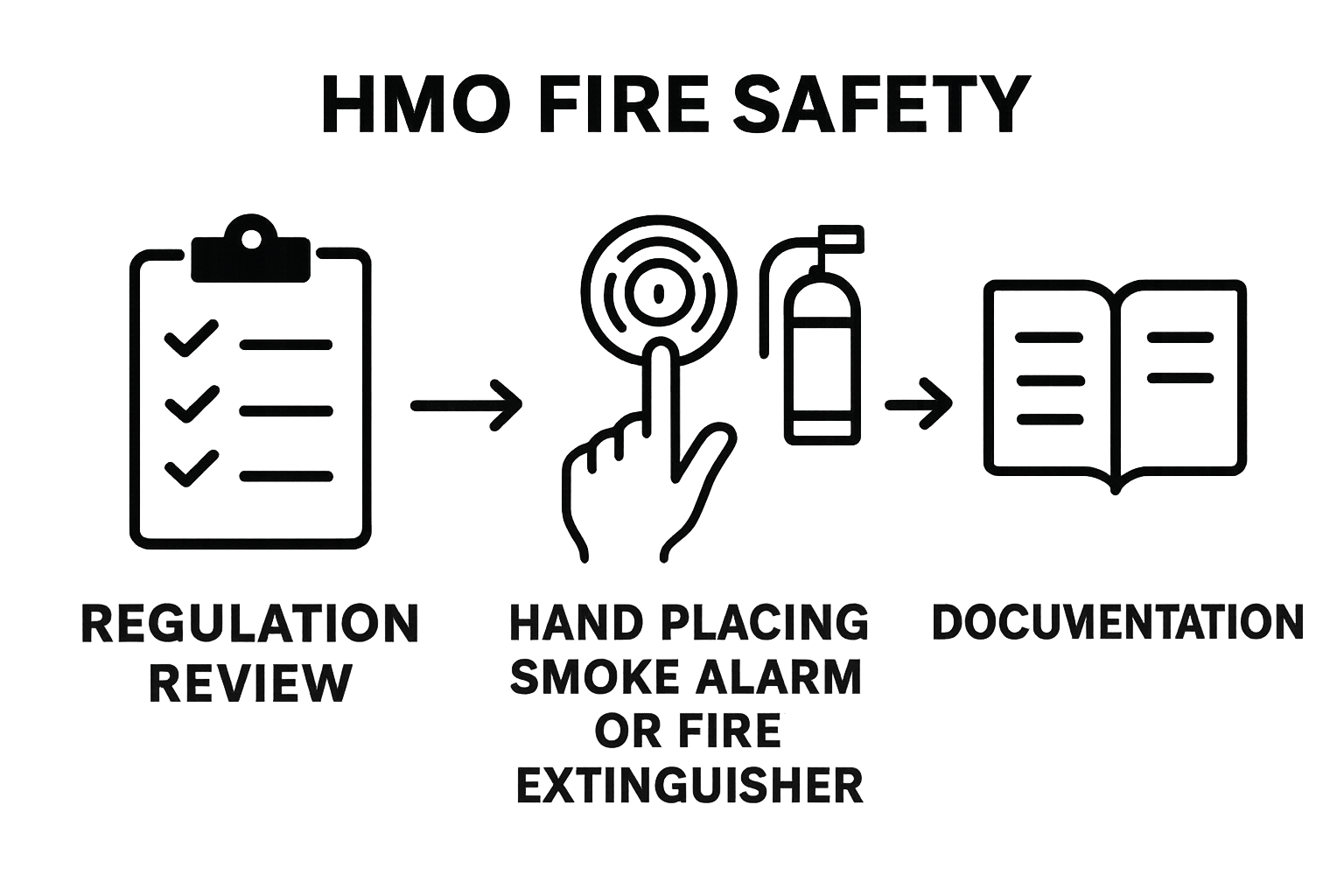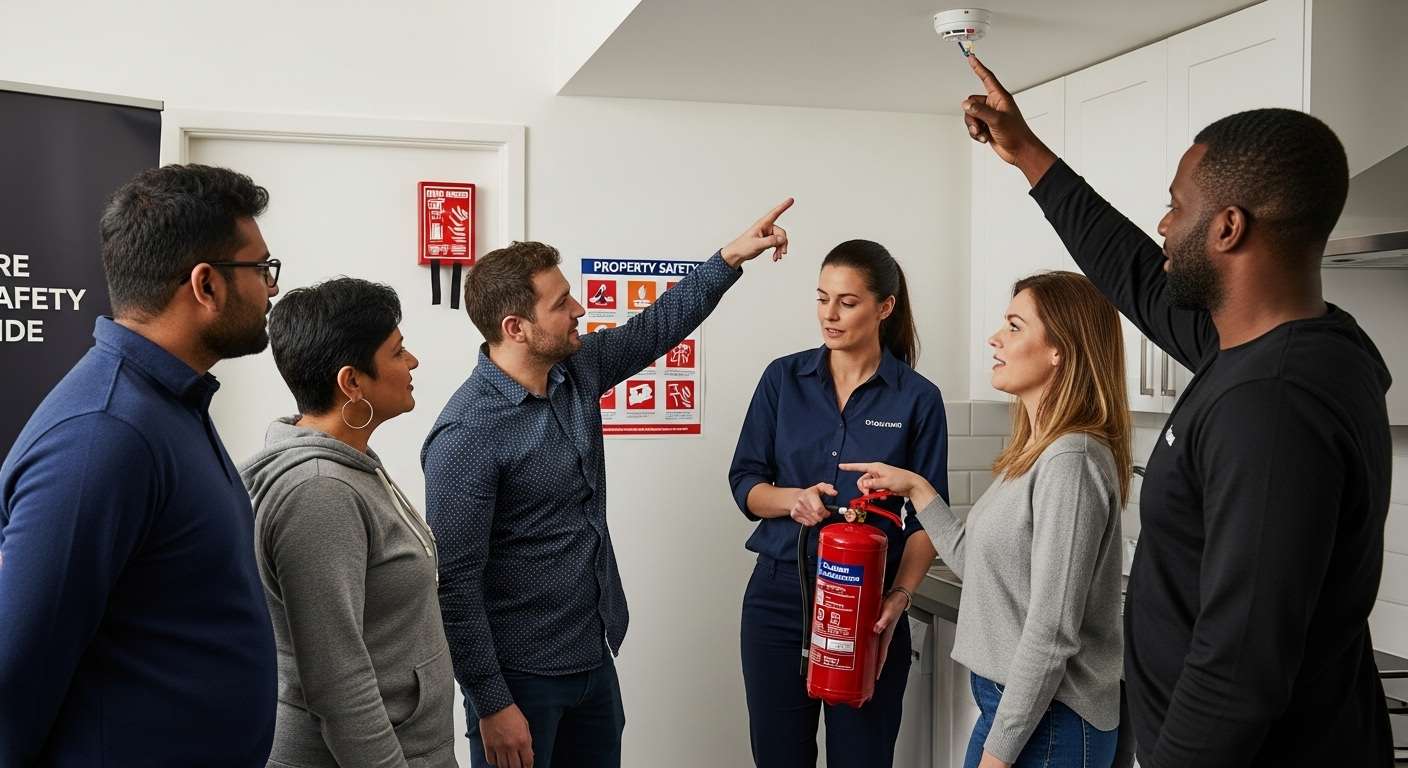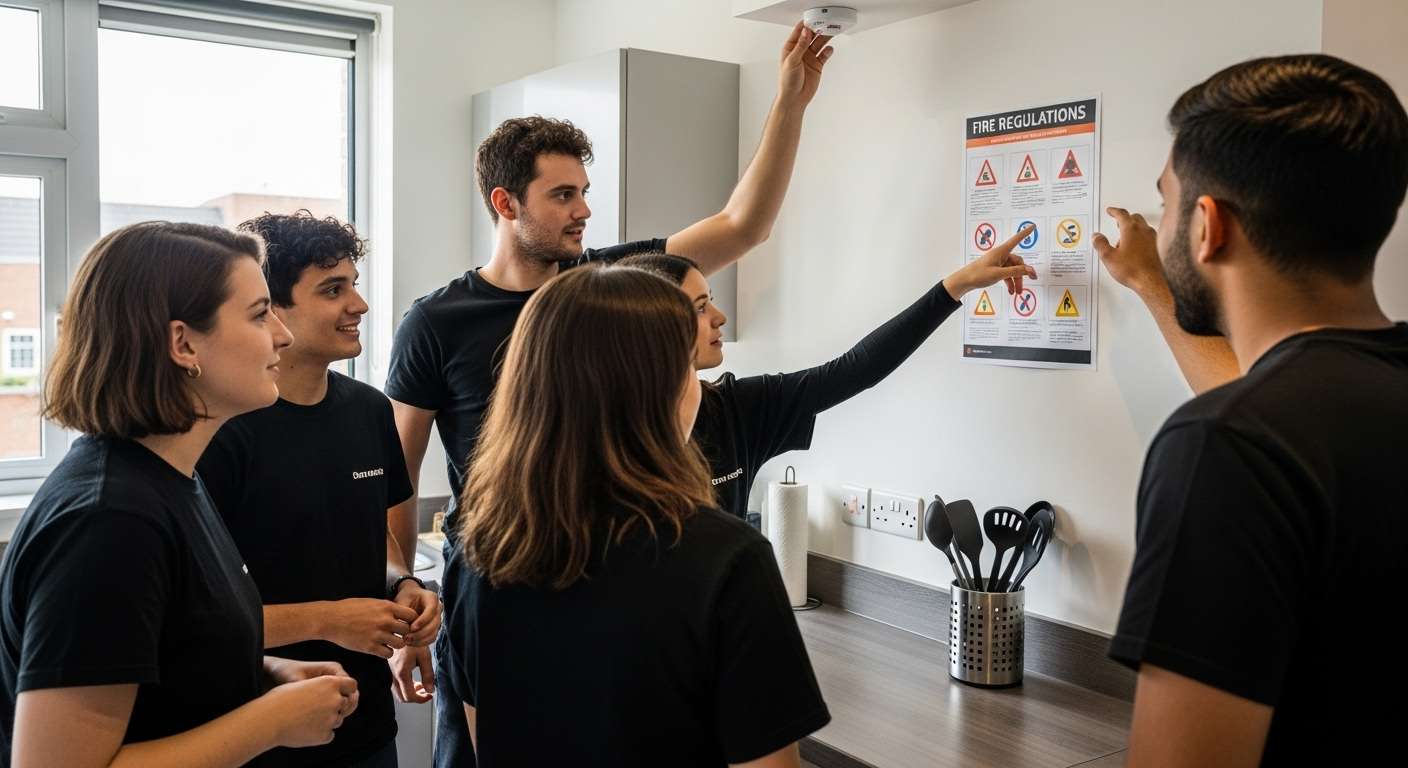Managing fire safety in HMOs is one of the most demanding responsibilities faced by landlords in the UK, where HMO properties are legally required to meet far stricter safety standards than single lets. Most people expect a simple checklist will cover their bases. Actually, the true challenge is knowing that compliance relies on far more than ticking boxes and that even a minor oversight can lead to heavy fines or prosecution. The surprises start when you see just how much difference a detailed plan and ongoing documentation make for total peace of mind.
Quick Summary
| Key Point | Explanation |
|---|---|
| 1. Identify Specific Fire Regulations | Review local and national fire safety regulations tailored to HMOs to ensure compliance and tenant safety. |
| 2. Conduct Comprehensive Equipment Assessment | Evaluate fire safety equipment needs based on property characteristics and risks to determine necessary tools for safety. |
| 3. Install Proper Fire Safety Devices | Ensure smoke alarms and extinguishers are correctly placed for effective fire prevention and tenant protection. |
| 4. Regularly Conduct Fire Safety Drills | Implement drills to train tenants on evacuation procedures, improving their response in actual emergencies. |
| 5. Document Compliance Thoroughly | Maintain detailed records of fire safety actions, assessments, and equipment to demonstrate compliance and due diligence. |
Step 1: Identify Required Fire Safety Regulations
Navigating fire safety regulations for Houses in Multiple Occupation (HMOs) requires a strategic and thorough approach. Identifying the specific fire safety requirements is the critical foundation of your comprehensive HMO fire safety checklist. Local authorities and fire safety regulations mandate specific standards that landlords must meet to ensure tenant protection and legal compliance.
Understanding the regulatory landscape begins with recognizing that fire safety regulations vary depending on your property’s size, occupancy, and specific usage. Research from the UK Fire Service indicates that HMOs face more stringent requirements due to their complex occupancy structures. Property owners must meticulously review local council guidelines and national fire safety legislation to develop a robust compliance strategy.
To effectively identify required regulations, landlords should initiate a comprehensive review process. This involves contacting your local fire and rescue authority to obtain specific guidance for your HMO property. Key documentation you will need to gather includes building regulations certificates, previous fire risk assessments, and current safety compliance records. Landlords must pay particular attention to specific requirements such as:
- Fire door installations and maintenance
- Emergency escape route specifications
- Fire alarm and detection system standards
- Electrical safety certification
- Furnishing fire resistance requirements
Successful regulation identification requires proactive engagement with professional fire safety consultants who can provide detailed insights into your specific property’s compliance needs. These experts can help you navigate the complex regulatory environment, ensuring that your HMO meets all necessary safety standards. Documentation is crucial during this process, so maintain meticulous records of all assessments, communications, and compliance efforts.
Verification of your regulation identification step involves confirming that you have a comprehensive understanding of all applicable fire safety requirements specific to your HMO property. This includes having a written document outlining the exact regulations, potential compliance challenges, and a clear action plan for meeting all safety standards.
Step 2: Assess Fire Safety Equipment Needs
Assessing fire safety equipment needs represents a critical phase in developing a comprehensive HMO fire safety checklist. This step transforms your regulatory knowledge into practical protection strategies, ensuring your property is equipped with the right tools to safeguard tenants and comply with safety standards. Research from the Health and Safety Executive emphasizes the importance of strategic equipment selection tailored to specific property characteristics.
Beginning the assessment requires a systematic walkthrough of your entire HMO property, examining each room and shared space with a critical eye for potential fire risks. Property owners must consider multiple factors including property layout, occupancy levels, and potential escape routes when determining appropriate fire safety equipment. This comprehensive evaluation goes beyond simply purchasing standard fire extinguishers and involves understanding the unique vulnerabilities of your specific multi-occupancy environment.
Essential fire safety equipment for HMOs typically includes:
- Smoke detectors in every bedroom and shared living space
- Carbon monoxide detectors near fuel-burning appliances
- Fire extinguishers appropriate for different fire classes
- Fire blankets in kitchen areas
- Emergency lighting in corridors and escape routes
- Fire alarm systems with interconnected sensors
Quality and strategic placement of equipment matter as much as the equipment itself. Landlords should prioritize professional-grade devices with robust performance ratings and ensure they are installed at recommended heights and locations. Consulting with a certified fire safety professional can provide invaluable insights into optimal equipment selection and positioning.
Verification of your equipment assessment involves creating a detailed inventory documenting each piece of fire safety equipment, its location, installation date, and upcoming maintenance requirements. This documentation serves not only as a compliance record but also as a critical tool for ongoing safety management. Regular equipment checks and maintenance schedules are crucial to ensuring continued effectiveness and meeting legal obligations.
Step 3: Install Smoke Alarms and Fire Extinguishers
Installing smoke alarms and fire extinguishers represents a pivotal moment in your HMO fire safety checklist, transforming theoretical safety planning into tangible protection. Research from the Fire Safety Advice Centre confirms that proper installation is as crucial as selecting the right equipment for comprehensive fire prevention.
Beginning the installation process requires careful strategic planning. Smoke alarms should be positioned to provide maximum coverage, ensuring no area of the property remains unmonitored. For multi-level HMOs, this means installing interconnected alarms that trigger simultaneously when one detects smoke, creating a comprehensive early warning system. Property owners must consider ceiling heights, potential obstructions, and room layouts to determine optimal alarm placement.
Key installation considerations include:
- Placing smoke alarms in every bedroom and shared living space
- Installing heat detectors in kitchen areas
- Positioning alarms at least 30 centimetres from walls and light fixtures
- Ensuring battery-powered units have easily accessible backup batteries
- Mounting fire extinguishers near potential fire risk areas
Fire extinguisher placement demands equal precision. Landlords should strategically position extinguishers in high-risk zones such as kitchens, near electrical panels, and along primary escape routes. Different types of fire extinguishers address various fire classes, so selecting multi-purpose units or a combination of specialized extinguishers provides comprehensive protection. Professional installation or consultation can help ensure correct mounting height and accessibility.

Verification of this step involves creating a detailed installation documentation that includes precise locations of each smoke alarm and fire extinguisher, installation dates, manufacturer details, and upcoming maintenance schedules. Conducting an immediate test of all installed devices confirms proper functionality, with tenants receiving clear instructions on alarm and extinguisher locations and basic operational guidance.
Step 4: Conduct Regular Fire Safety Drills
Conducting regular fire safety drills transforms theoretical knowledge into practical preparedness, creating a critical layer of protection in your HMO fire safety checklist. Research from the National Fire Chiefs Council emphasizes that practical training significantly improves tenant response during genuine emergency situations.
Successful fire drills require meticulous planning and sensitivity to the diverse tenant demographics typical in HMO environments. Property owners must design drills that accommodate varying ages, physical abilities, and potential language barriers. The goal extends beyond simple evacuation procedures to building genuine confidence and muscle memory for emergency responses. This means creating scenarios that feel realistic without causing unnecessary panic or distress.
Essential fire drill preparation elements include:
- Providing advance written notice to all tenants
- Establishing clear communication protocols
- Developing multiple evacuation route options
- Documenting drill performance and identifying improvement areas
- Ensuring all tenants understand alarm recognition and response procedures
Implementing these drills requires a structured approach. Schedule drills at unpredictable times to simulate genuine emergency conditions, while ensuring tenants understand the importance of participation. Consider working with local fire services who can provide professional guidance and potentially participate in training sessions. Landlords should maintain detailed records of each drill, noting participant responses, evacuation times, and any challenges encountered during the exercise.
Verification of this step involves creating a comprehensive fire drill log documenting date, participants, evacuation times, identified improvement areas, and follow-up actions. Success is measured not just by completion but by demonstrating progressive improvement in tenant emergency preparedness and confidence.
Step 5: Review and Update Fire Safety Protocols
Reviewing and updating fire safety protocols represents the continuous evolution of your HMO fire safety checklist, ensuring that your property remains protected against changing risks and regulatory requirements. Research from the Fire Safety Advice Centre highlights the dynamic nature of fire safety management, emphasizing the need for proactive and regular protocol assessments.
The review process begins with a comprehensive examination of existing fire safety documentation, comparing current practices against the latest regulatory standards and technological advancements. Property owners must approach this step with a critical eye, recognizing that fire safety is not a static concept but a continually developing field. This involves scrutinizing previous risk assessments, drill performance records, and any incident reports to identify potential areas of improvement.
Key elements to evaluate during protocol review include:
- Changes in local fire safety regulations
- Technological advancements in fire detection and prevention
- Feedback from previous fire safety drills
- Tenant demographic shifts
- Recent property modifications or structural changes
- Updated manufacturer recommendations for safety equipment
Successful protocol updates require a holistic approach that goes beyond paperwork. Landlords should engage with fire safety professionals, local fire authorities, and potentially consult with insurance providers to gain comprehensive insights. This collaborative approach ensures that updates are not just theoretical but practically implementable. Consider scheduling annual professional assessments that provide expert recommendations tailored to your specific HMO property.
Verification of this step involves creating a detailed update log documenting all changes, rationales, and implementation dates. Success is measured by demonstrating a systematic, evidence-based approach to fire safety management that shows continuous improvement and proactive risk mitigation. The ultimate goal is to develop a living document that adapts to emerging safety challenges and regulatory requirements.
Step 6: Document and Verify Compliance Checks
Documenting and verifying compliance checks represents the final critical stage in your HMO fire safety checklist, transforming previous actions into a legally defensible and professionally managed safety strategy. Research from the Health and Safety Executive emphasizes the importance of comprehensive documentation in demonstrating due diligence and protecting both tenants and property owners.
The documentation process requires meticulous attention to detail, creating a systematic record that captures every aspect of your fire safety management. Property owners must develop a robust filing system that goes beyond simple record-keeping, instead creating a comprehensive narrative of safety preparedness. This means developing a digital and physical archive that includes detailed logs of equipment installations, maintenance records, drill performances, risk assessments, and regulatory compliance evidence.
Essential documentation elements to include:
- Dated equipment installation certificates
- Maintenance and service records for fire safety equipment
- Completed fire risk assessment documents
- Tenant communication and training records
- Emergency contact information
- Photographic evidence of safety installations
- Professional inspection reports
Verification extends beyond simply collecting documents. Landlords should implement a regular audit process that critically examines the completeness and accuracy of compliance records. This might involve quarterly internal reviews and annual professional assessments that provide an independent evaluation of your documentation practices. Consider developing a checklist that ensures no critical documentation is overlooked, and create redundant storage systems to protect against potential data loss.
Successful verification is measured by creating a comprehensive, accessible, and up-to-date compliance portfolio that demonstrates proactive fire safety management. The ultimate goal is to develop a documentation system that not only meets legal requirements but also provides a clear, transparent record of your commitment to tenant safety and regulatory compliance.
Below is a checklist table to help landlords systematically verify their compliance with essential HMO fire safety documentation requirements.
| Documentation Requirement | Description | Frequency/Update |
|---|---|---|
| Equipment Installation Certificates | Proof of professional fitting for alarms/extinguishers | On installation/upgrade |
| Maintenance & Service Records | Log of when equipment is tested or serviced | Annually & after any service |
| Fire Risk Assessment Documents | Full property risk assessment and action plan | Annually/minimum legal review |
| Tenant Communication & Training Records | Record of safety notices, instructions, and drill logs | After each drill/update |
| Emergency Contact Information | Up-to-date emergency and authority contacts | Whenever changes occur |
| Photographic Evidence of Installations | Photos of all installed fire safety devices | On installation/change |
| Professional Inspection Reports | Reports from external fire safety consultants | Annually (at minimum) |

Take the Stress Out of HMO Fire Safety and Compliance
Managing HMO fire safety can feel overwhelming with complex regulations, regular compliance checks, and the constant need to protect your tenants and investments. This article highlights how missed steps in your HMO fire safety checklist and a lack of up-to-date documentation can risk both safety and legal status. You deserve a smarter, simpler way to keep your HMO properties compliant while saving time and worry.
Let AgentHMO help you bridge the gap between regulatory demands and confident property management. Explore our comprehensive HMO property solutions and discover trusted service providers, compliance resources, and a vibrant professional network tailored to HMOs. Do not wait until an inspection uncovers gaps. Join a community that puts safety and compliance at the core. Visit https://agenthmo.co.uk today to streamline your fire safety and unlock peace of mind for your HMO portfolio.
Frequently Asked Questions
What are the key fire safety regulations for HMOs?
Landlords must comply with regulations related to fire door installations, emergency escape routes, fire alarm system standards, electrical safety certification, and furnishing fire resistance requirements.
How should landlords assess their fire safety equipment needs for HMOs?
Landlords should conduct a thorough walkthrough of the property, considering layout, occupancy levels, and potential fire risks. Essential equipment includes smoke detectors, carbon monoxide detectors, fire extinguishers, and emergency lighting.
What steps should be taken to install smoke alarms and fire extinguishers in an HMO?
Smoke alarms should be installed in every bedroom and shared living space, with interconnected alarms for multi-level properties. Fire extinguishers need to be placed in high-risk areas. Professional installation ensures optimal placement and functionality.
How often should fire safety drills be conducted in an HMO?
Regular fire safety drills should be scheduled at unpredictable times to simulate real emergency conditions. This enhances tenant preparedness and confidence. Documentation of each drill helps to identify areas for improvement.



